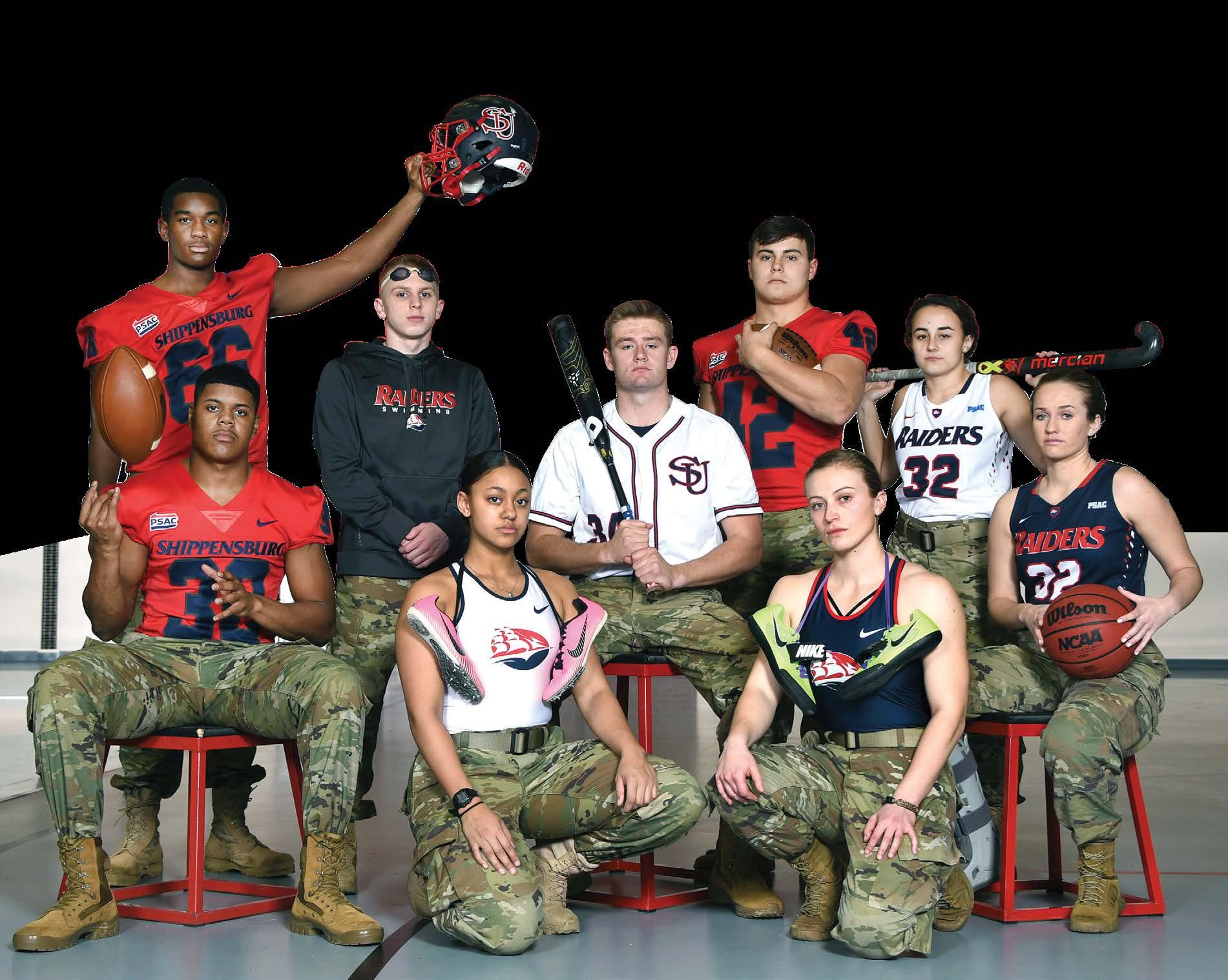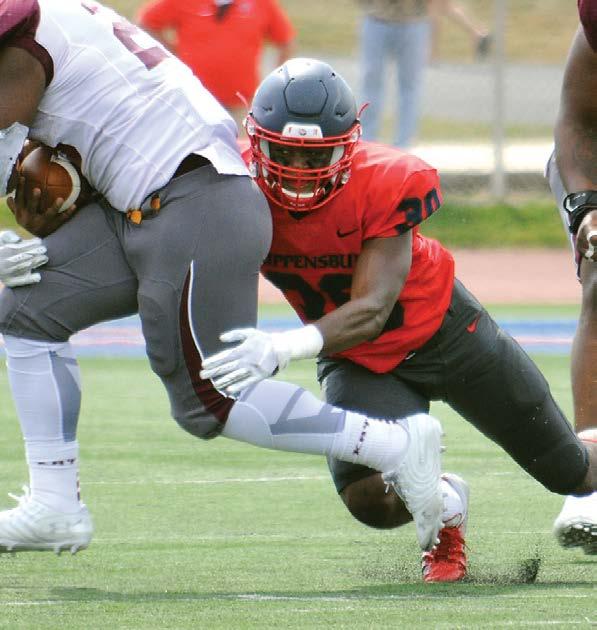
5 minute read
Representing School and Country
ROTC Student-Athletes Embrace the Challenge
BY MACI THORNTON ’21M

Participating in college athletics requires intense commitment, but playing a college sport as an officer-in-training adds another dimension. ROTC student-athletes represent both their school and their country in the classroom and on the field. They work to achieve peak academic and physical excellence as future officers in the US Military.
This commitment to the pursuit of excellence creates a common misconception: cadets cannot successfully navigate academics, athletics, and ROTC. “When I first came here as the department chair, we had zero cadets who were NCAA athletes, and it was really important to me to build our partnerships with athletics,” said Lt. Col. Chris Morton. “Athletes make great Army officers.” Plus, he said, having ROTC student-athletes benefits the university, the Athletic Department, the ROTC program, and the students individually.
In fact, Shippensburg University has graduated successful ROTC studentathletes in the past. In 2012, starting football kicker
Michael Lloyd set a school record with 80 points by kicking in a single season. Nichole Capozzi earned All-America honors in swimming during the 2010-2011 season and graduated as a second lieutenant in 2012.
Shippensburg University currently has the largest group of ROTC student-athletes in school history. Nine members of the Raider Battalion prove participating in college sports and ROTC is not only possible, but beneficial.


Motivation to Participate
Most students interested in both ROTC and playing a college sport anticipate a major level of commitment. The Raider Battalion student-athletes provided insight toward their motivation to join ROTC and compete for SU Athletics.

Savannah Mower
Savannah Mower, a firstyear track and field athlete, said she joined both because of “the passion for athletics— for competing.” In fact, she believes the Army is like a sports team.
“I felt like ROTC was something different—something to get me out of my comfort zone,” added Kayla Brooks, another first-year track and field athlete.
First-year student-athlete, Fiona Rowan, made history as the first member of the women’s basketball team to also participate in ROTC. “After I committed here to play basketball, I was told I couldn’t do ROTC. I definitely want to show people that you can do it, too, that you’re not limited because of other activities you are involved in,” she said.
A Demanding Schedule
Most cadets expect a busy schedule coming into the program, especially those aspiring to also play a college sport. Laron Woody, a first-year student-athlete, explained a typical day for an ROTC cadet during football season:




“We have morning meeting at 6:00am, 8:00am class for ROTC, and after that, we would go to any other classes we have for the day. I take four to five classes a semester. We have lifting anywhere from 11:00am to 2:00pm. Then, we have football practice from 3:15 to 6:15pm. We go home to do homework and study hall, which starts right after practice.” Woody joked that they squeeze in time to eat and sleep as well.
He stressed the importance of time management and communication. Regular communication with ROTC superiors, coaches, and professors is essential to managing rigorous schedules.
First-year swimmer Matthew Bochansky praised his professors for their communication and consideration of his schedule.
“They’re usually pretty understanding of what I have going on and the schedule I have to work with,” he said.
Rowan agreed, adding, “In addition to basketball and ROTC, I’m also in the Honors College, so that comes with a lot of extra work in certain classes I have to take. The director of the Honors College, Dr. Kim Klein, is very good about understanding my work load.”
Rigorous Training
On top of ROTC physical training, these student-athletes manage practices and competitions in their sport. However, the cadets believe training in their sport improves their athleticism, thus benefitting them in ROTC physical training.
Mower provided insight on the new ROTC physical training test, “It is more geared toward athleticism versus endurance and how many push-ups and sit-ups you can do in a couple minutes. I think that being in a sport will better prepare us for the new Army combat fitness test.”
In fact, training in their sport may replace ROTC training sessions depending on scheduling or the nature of the training. Firstyear student-athlete Tyler Simon revealed his pre-season football schedule of running two mornings a week and lifting four times a week. “It’s a little too much to do both,” said Simon, and the cadets see little benefit to exhausting themselves.


The Future in Focus
Several parallels exist between the lessons learned from ROTC and college athletics. These cadets are self-motivated due to their numerous obligations, but Mower lists confidence as her main takeaway. “ROTC forces you to get out of your comfort zone and be comfortable being uncomfortable. That translates into athletics as well.”
Lake Lloyd, a sophomore baseball student-athlete, said participating in ROTC and athletics taught him to hold himself to a higher standard. ROTC student-athletes represent their school and their country, meaning, “they don’t just see me as No. 34—they see me as a cadet,” which he does not take lightly.
Rowan articulated the humility she experienced as a first-year member of the women’s basketball team. “I was very humbled as a leader with basketball and listening to older players who are more experienced than I am.” This translated into ROTC by learning to respect people in higher positions, she said, which is an important skill moving forward.
The Raider Battalion student-athletes plan to use all they have gleaned from their experiences toward their future goals as officers and professionals in their desired career.
William Humphrey, a first-year member on the football team, intends to commission after graduation. As someone who grew up in a military town in North Carolina, he said that becoming an officer and retiring out of the military has been his main goal.
Katelyn Nalesnik, a first-year field hockey player, majors in biology and hopes to become a nurse. She believes her Army training will benefit her tremendously in her nursing career.
Participating in ROTC and college athletics provides these cadets with an “edge,” as Lloyd mentioned. While challenging, they believe both experiences better equip them for a future in service and leadership. The Raider Battalion student-athletes prove the misconception false, demonstrating ROTC and college athletics can work together and benefit each other.
Maci Thornton ’21M is a graduate assistant in SU’s Office of Communication and Marketing.



